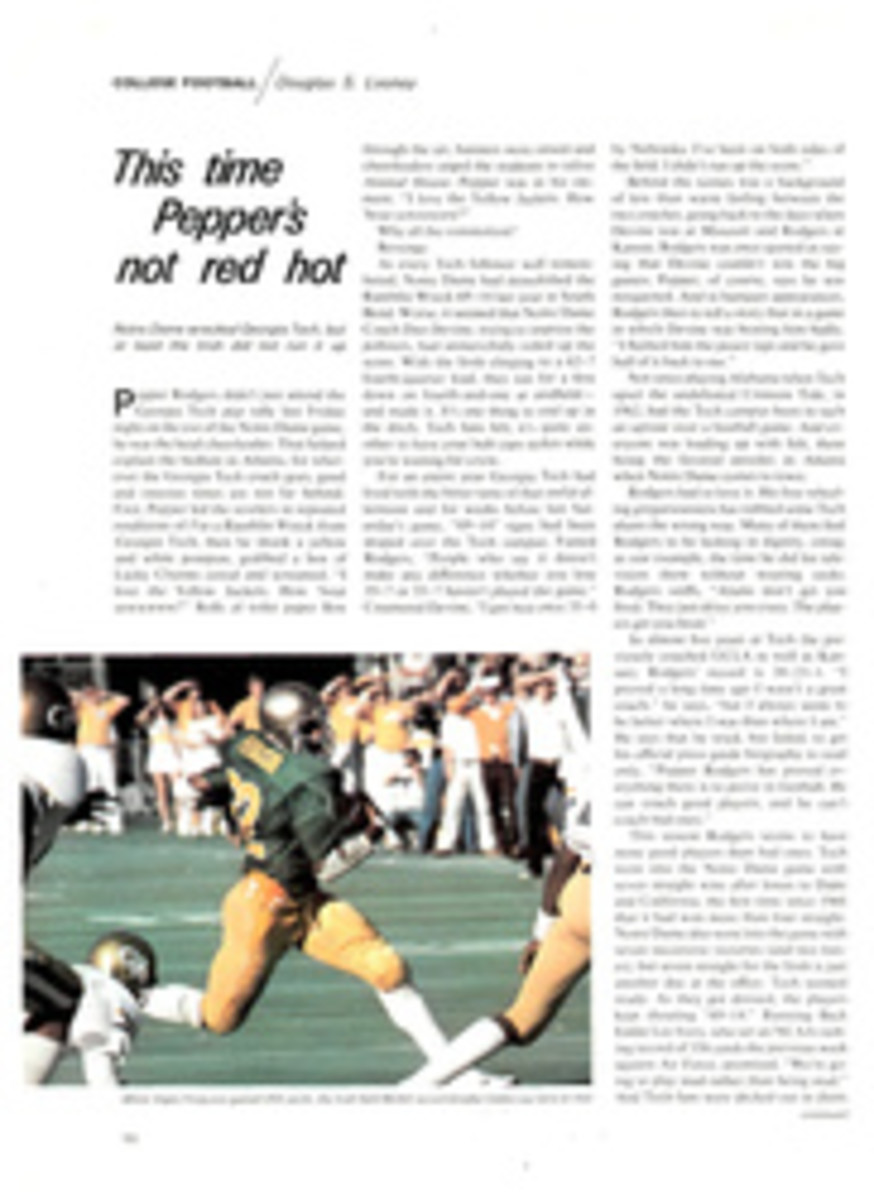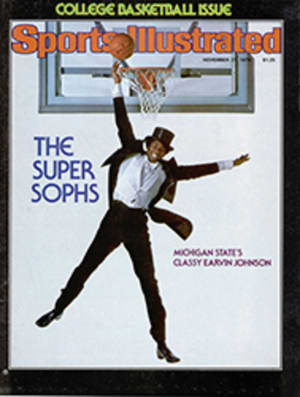
DREAM GAME THAT CANNOT COME TRUE
Lost in the Babel of northwest Chicago is a school called North Park College and Theological Seminary, 25 acres of campus crammed with mostly nondescript buildings and crawling with pretty, mostly blond people. North Park was founded in 1891 to further the works of the Evangelical Covenant Church of America, and 86 years later it came up with the best NCAA Division III basketball team in the land. That's not exactly the mission the Swedish founders had in mind, but no one's complaining.
North Park is a quiet school, so quiet that back in 1970, while most colleges agonized over the Vietnam war, North Park's students were distressed by a ban on campus dances. It's also a small school, so small that it's hard to find. What you have to do is go to the corner of Foster and Kedzie and look for the chartreuse streamer over the gymnasium that proclaims: NORTH PARK VIKINGS, 1978 NCAA BASKETBALL CHAMPIONS. The makers of the banner would not have been overly presumptuous had they added 1979 and 1980, because the Vikings are, in a word, loaded. The top three scorers will be back from a team that finished 29-2 and ended the season with a 21-game win streak.
North Park is located within a chest pass of Chicago's Greek and Spanish neighborhoods, the Bohemian National Cemetery, the Korean Missionary Church and a synagogue. So at this Swedish college they think it is only natural that the basketball coach, Dan McCarrell, is of Irish descent, and his assistant, Bosko Djurickovic, is Serbian. And it is not at all odd that the Vikings' three best players are black, because the North Park student body, though predominantly of Scandinavian extraction, is varied.
The school's main attraction for its diverse students is that it is a bucolic enclave in the nation's second-largest city. The school has 1,167 men and women students, all of whom go bananas over basketball. At one of last season's games the usual raucous crowd of 2,000 included 50 of the country's 550 Evangelical Covenant ministers, who were in Chicago for a theological conference. They cheered so lustily that some even seemed to be, ahem, dancing.
During 11 years as North Park coach, McCarrell has usually kept Viking fans hopping. But last season he showed them some entirely new steps. After winning the College Conference of Illinois and Wisconsin, the Vikings beat Rip-on (Wis.), Minnesota-Morris, Humboldt (Calif.) State and Albion (Mich.) to reach the Division III final, in which they overwhelmed Widener of Pennsylvania 69-57. And they did all this with two sophomores and a freshman scoring two-thirds of the points.
The big man is Center Michael Harper, a 6'10" junior and a resident counselor who averaged 18.5 points and 14.3 rebounds. Junior Modzel Greer, a 6'7" forward, scored 16 points and had 7.9 rebounds a game, and sometimes will step in at guard to handle the ball.
It wasn't just happenstance that Greer and Harper turned up at North Park. McCarrell attends a million high school games every winter, and when he first saw Harper, he was a needle-thin 6'5" forward on a mediocre team. Even during Harper's freshman year at North Park, McCarrell wondered if he could play, because he fainted twice during games. No wonder. Harper was in the process of growing about three stories in six months. After McCarrell fed him some Nutrament, Harper earned his nickname, the Chicago Eraser. Greer ended up at North Park because the big-time recruiters failed to notice him as he played low post on a guard-oriented offense.
The final—and perhaps biggest—reason for North Park's success was the arrival last season of Michael Thomas, another of this season's classy sophomores. As point guard, Thomas ran the Viking offense and averaged more than 19 points over the last 10 games. He was McCarrell's big catch; because he was the star of Illinois' powerful Proviso East High, several Division I schools wanted him. "The big places confused me," says Thomas, "and I wanted to go where I could play right away and my family could see me."
McCarrell runs a tight practice—"He keeps our heads small and our bodies tired," Thomas says—but he lets the Vikings loose during games. They play a running offense and press almost constantly. When they fail to score off the break or a steal, the Vikings can either work the ball into Harper or let Greer or Thomas fire from afar.
North Park's biggest stumbling block in trying to repeat as champion may be the very nature of Division III basketball. In the last four years there have been four different titlists. This season, California's Whittier College, with All-America Mike Brown, could knock off North Park and make it five different champs. Humboldt State and Widener are strong once more, and Stony Brook (N.Y.) and Albion could very well end up in the final four. But, oddly, perhaps the toughest opponent for North Park will again be left out. "I'd love to play Hamilton," says McCarrell.
Lost in central New York's Mohawk Valley is something off a postcard, called Hamilton College. Though it is 166 years old, Hamilton, which is in Clinton, even has an identity problem in its home state, because New Yorkers get it confused with Colgate University in nearby Hamilton or the Clinton Correctional Facility in Dannemora.
Although hardly anybody has heard of Hamilton—and many of those who have cannot quite remember what or where it is—the place has a number of famed graduates, Elihu Root, Ezra Pound, Alexander Woollcott and B. F. Skinner among them. But not one of them or many other Hamilton alumni could dunk. That's why it is strange that in the last three years Hamilton's team has gone 66-12. As one old grad wrote, "What the hell's going on up there?"
Because Hamilton cherishes scholarship—it is one of the better colleges in the country—far more than athletics, the Continentals are forbidden to compete in the Division III tournament. They belong to the New England Small College Athletic Conference, and the rub is that the NESCAC prohibits its members from postseason play that occurs more than one weekend after the end of the regular season. The Division III finals are held one week too late.
Every few days or so, Tom Murphy, the basketball coach, curses the rule. "I know that in one of the last three years, we could have won the whole thing," he says. But then Tom Murphy, the tenured professor, calms down. "If the administration stressed athletics, it wouldn't be Hamilton."
Hamilton people point with pride to pages 212-214 of Sports in America, where James Michener writes that if he were to run an athletic program, he would run it as Hamilton has. No recruiting budget. No athletic scholarships. Studies first. Hamilton's idea of a perfect record, it seems, is 11-11. That way the players learn equally the lessons of winning and losing.
In Murphy's first season, 1970-71, the Continentals did a lot of work on the losing part. They were 1-15. During the next three years they won a total of 14 games. In the watershed season of 1974-75, Hamilton finished 12-10 and everybody was happy. Then Cedric Oliver arrived.
Oliver learned his basketball in the Bronx and then went to Proctor High in Utica, where he lived with his grandmother. While at Proctor, Oliver more than held his own against Dale Shackle-ford, now a star at Syracuse. When he had to decide on a college, Oliver's educationally minded grandmother pushed and Murphy dragged him to nearby Hamilton.
In Oliver's first year he led the Continentals to a 22-4 record and the championship of the ECAC region. In '76-77 Hamilton went 21-5 and lost in the Eastern final to Potsdam (N.Y.) State. Last year's 23-3 team was easily the best in the school's history, but the Continentals still had no business beating Division II power Adelphi by nine points or Division I Colgate by 20, a victory that made Hamilton students sneer in a southwesterly direction.
Murphy has come a long way from the days when he was afraid to show prefreshmen—they're never called recruits at Hamilton—Alumni Gym, a 38-year-old edifice with all the charm of an old sweat sock. Today Hamilton has a new athletic complex designed by the people who dreamed up the Hartford Civic Center of SNOW CAVES IN ROOF fame. It is hoped that the architects learned their lesson, because the first snow fell in Clinton in September.
Hamilton should be just about as strong this season as it was last. The 6'4" Oliver is back, and he averaged 23.4 points a game, led the Continentals in rebounding and made the Division III All-America team. Three other starters, Center Kevin Grimmer, Forward Billy Southworth and Guard Johnny Magee, return, too.
"I'd love to play North Park," says Murphy. "We don't have too much talent. But we have it here." Murphy points to his heart. In the interest of equal time, the administration would also like him to point to his head.
The NCAA Division II defending champ, Cheyney (Pa.) State, looks tough again, with three of its five starters returning, including star Forward Andrew Fields. Florida Tech, which finished in the final four last year, should be helped by the return of Coach Torchy Clark's son Bo, who was third in the nation in scoring two years ago before sitting out 1977-78 with an injury. New York Tech, Philadelphia Textile, Eastern Illinois and Wisconsin-Green Bay will all be contenders.
With defending champion Grand Canyon of Arizona rebuilding, the NAIA should be dominated by the Central Intercollegiate Athletic Conference, which includes Norfolk (Va.) State, Winston-Salem (N.C.) State and Hampton (Va.) Institute. Any of the three is capable of being No. 1. The NAIA's mystery team is Winthrop (S.C.) College, which is in its first year of intercollegiate basketball. Two years ago Coach Nield Gordon came up the road a piece from 36—1 Newberry College, bringing with him two not-quite-identical twins (Ronnie Creamer is 6'9", his brother Donnie is 6'10") and 6'11" Alan Ours. Gordon himself is 6'6". Beating Winthrop could be a tall order.
PHOTO
North Park's Thomas is another distinguished sophomore.

